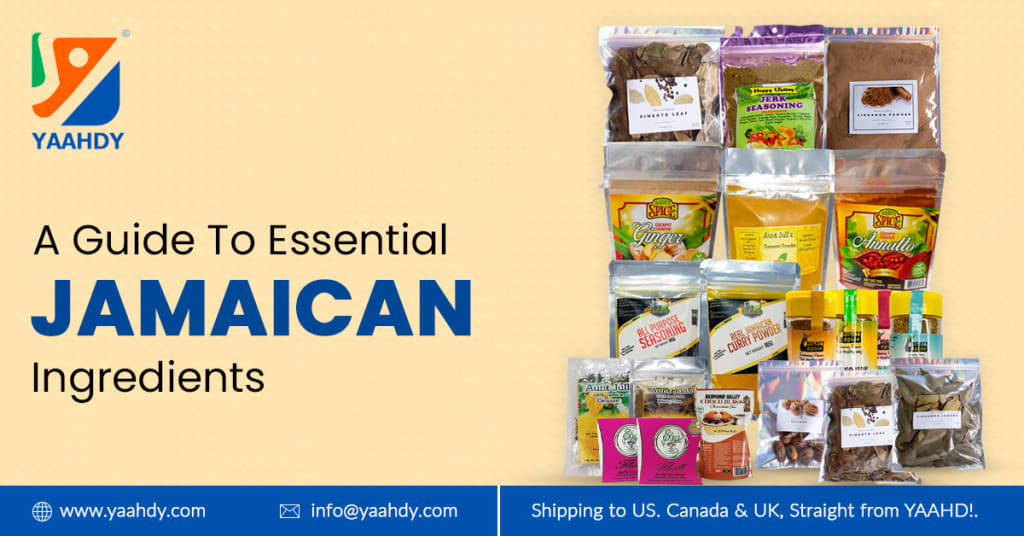
Jamaican cuisine, a vibrant tapestry of African, European, and indigenous influences, boasts a unique flavor profile that has captivated palates worldwide.
From the fiery heat of jerk chicken to the comforting richness of ackee and saltfish, Jamaican food is an explosion of taste and texture. But what are the secret ingredients that give this cuisine its irresistible character?
This guide delves into the essential Jamaican ingredients, unlocking the culinary secrets of the island paradise.
1. Ground Provisions
Jamaican cuisine heavily relies on root vegetables, known as "ground provisions." These starchy staples provide sustenance and versatility, forming the base for many dishes. Here are some key players:
Yams: These come in various colors (white, yellow, orange) and textures (firm, starchy, sweet). Yams are boiled, roasted, mashed, or fried, starring in dishes like yam and callaloo soup or creamy yam fries.
Sweet Potatoes: A versatile ingredient, sweet potatoes are enjoyed roasted whole, mashed with butter and spices, or grated and fried into golden fritters (festival).
Plantains: These close cousins of bananas can be enjoyed green or ripe. Green plantains are boiled, fried into savory tostones, or grated for dumplings. Ripe plantains caramelize beautifully when fried (fried plantains) or boiled for sweet plantain porridge.
Breadfruit: This starchy fruit boasts a unique texture and can be boiled, roasted, fried, or even used to make vegan pulled "pork."
Cassava: The base for bammy, a flatbread made from grated, fermented cassava. Cassava can also be boiled and mashed (like flour) for use in soups and stews.
2. Greens that Gleam: Callaloo and Beyond
Leafy greens are a vital source of vitamins and minerals in Jamaican cooking. Callaloo, a dark green, iron-rich vegetable with a slightly bitter taste, takes center stage. It's simmered in stews, soups, and used to make flavorful callaloo fritters. Other noteworthy greens include:
Spinach: A common substitute for callaloo, offering a milder flavor.
Cho Cho (Chayote): A pear-shaped green vegetable with a mild flavor. It's often added to soups and stews for a textural contrast.
Pumpkin Leaves: Tender, heart-shaped leaves with a slightly sweet flavor, used in soups and stews.
3. The Allure of Ackee: Jamaica's National Fruit
Ackee, a bright red fruit with black seeds, might seem unusual at first glance. But when combined with saltfish (codfish), it becomes Jamaica's national dish, Ackee and Saltfish. Ackee has a creamy, slightly buttery flavor when ripe, but caution is advised: unripe ackee is toxic. Ackee is also enjoyed scrambled with eggs or boiled and served as a side dish.
4. Pimento and Scotch Bonnet Peppers: The Fiery Duo
Jamaican cuisine wouldn't be the same without its signature heat. Here are the two main players:
Pimento (Allspice): These dried berries, not to be confused with allspice berries found elsewhere, offer a warm, complex flavor with hints of clove, cinnamon, and nutmeg. Pimento is a staple in jerk seasoning and adds depth to rice and peas, stews, and marinades.
Scotch Bonnet Pepper: This fiery pepper packs a punch and is a key ingredient in jerk seasoning. Use it sparingly! Scotch bonnet peppers can be used fresh, dried (known as "boney" pepper), or pickled (known as "pepper shrimps").
5. The Aromatic Symphony: Herbs and Spices
Jamaican cuisine uses a vibrant blend of herbs and spices to create its signature flavors. Here are some essentials:
Thyme: Fresh thyme is a cornerstone of Jamaican cooking, adding an earthy, herbaceous aroma to rice and peas, stews, and jerk marinades.
Scallions: These green onions add a sharp, pungent flavor to Jamaican dishes.
Garlic: A base for many Jamaican sofritos (sauteed aromatics), garlic adds depth and savory notes to dishes.
Nutmeg: Used sparingly but effectively, nutmeg adds a warm, slightly sweet touch to rice and peas, soups, and stews.
Black Pepper: Freshly ground black pepper adds a touch of heat and complexity to many Jamaican dishes.
6. Coconut: A Versatile Island Gem
The coconut palm plays a vital role in Jamaican cuisine. Coconut milk, derived from the grated flesh, adds a creamy richness to curries, soups, stews, and rice dishes.
Coconut water, the refreshing liquid from inside the young coconut, is a popular beverage. Grated coconut flesh (known as "coconut gratings") adds texture and sweetness to desserts and fried dishes.
Even coconut oil, extracted from the dried flesh, is used for cooking.
7. Beans and Pulses: Hearty Additions
Beans and pulses are a significant source of protein in Jamaican cuisine. Here are some commonly used ones:
Kidney Beans: A key ingredient in Jamaican rice and peas, a dish of red kidney beans cooked with rice, coconut milk, and spices.
Black Beans: Often used in stews and soups, black beans add a hearty texture and earthy flavor.
Gungo Peas (Pigeon Peas): These small green peas are featured in dishes like gungo peas soup and can also be stewed or curried.
8. Beyond the Spice Rack: Other Essential Ingredients
Scotch Bonnet Pepper Sauce: A bottled hot sauce made with scotch bonnet peppers, adding a fiery kick to any dish.
Pickled Peppers: Scotch bonnet peppers pickled in vinegar, used as a condiment or flavor enhancer.
Thyme Extract: A convenient substitute for fresh thyme, especially outside of Jamaica.
Curry Powder: While not native to Jamaica, curry powder has been adopted and adds a unique twist to Jamaican curries (often featuring chicken or goat).
Rum: A quintessential Jamaican spirit, rum is not just for cocktails! It's used in marinades for jerk meats, adds depth to rum cake, and flavors Jamaican sauces.
Tips for Using Jamaican Ingredients:
Start fresh whenever possible. Fresh herbs, vegetables, and peppers deliver the most vibrant flavors.
Adjust spice levels to your preference. Jamaican food can be fiery, but don't be intimidated. Start with smaller amounts of scotch bonnet peppers and adjust to your taste.
Explore Jamaican grocery stores or online retailers. Find authentic ingredients like callaloo, ackee (ensure it's ripe!), and pimento berries.
Don't be afraid to experiment! Once you're familiar with the essential ingredients, use them as a springboard to create your own Jamaican-inspired dishes.
Conclusion
Jamaican cuisine is a vibrant tapestry of flavors and textures, waiting to be explored. By understanding the essential ingredients and their unique characteristics, you can unlock the secrets of this delicious cuisine.
So, grab your pimento berries, fire up the pot, and embark on a culinary adventure to the heart of the Caribbean!
About the Creator
YAAHDY
With a user-friendly and secure online shopping experience, YAAHDY.COM is your passport to the best of the Caribbean. https://yaahdy.com/
Enjoyed the story? Support the Creator.
Subscribe for free to receive all their stories in your feed. You could also pledge your support or give them a one-off tip, letting them know you appreciate their work.






Comments
There are no comments for this story
Be the first to respond and start the conversation.